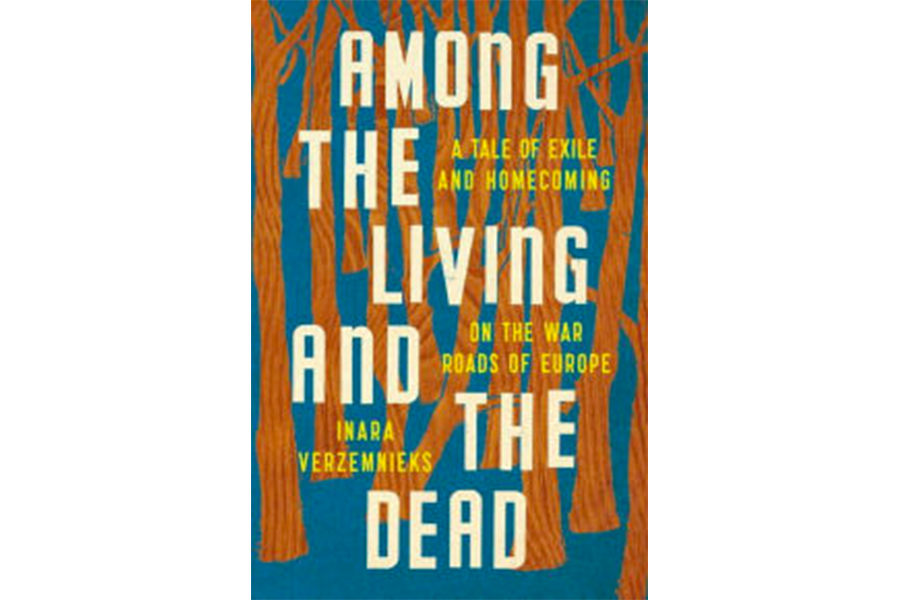'Among The Living And The Dead' is a moving search for traces of the author's Latvian family
Journalist Inara Verzemnieks fuses world history with personal history as she travels to Latvia to trace the surviving branches of her family.

Inara Verzemnieks grew up in the US, yet immersed in stories of the Latvian home her grandmother had left behind after World War II.
Summers were spent at a cultural camp where only Latvian was spoken, where the children and grandchildren of refugees learned folk dancing and "oral histories of the proper mounding of hay, instruction in the selection of wildflowers appropriate to the braided crowns worn by maidens on midsummer’s night."
After the death of her grandparents, who had chiefly raised her, Verzemnieks repeatedly visited the surviving branches of her family in that lost homeland “where landscape was lineage.” In her elegiac new book, Among The Living and The Dead, she describes how she hoped the faraway travels would restore her grandmother to her “in the old stories” that still existed there.
"In the region of Latvia where my grandmother was raised, there are people who believe even to this day that the right words spoken in the right combination are a way of resurrecting what has been lost. Or, as an old man asked me: Did I know that there were times when words could become more than words?" she wrote.
Ultimately, what she found was even broader: the meaning of home, the power of stories, and the different ways survivors and their memories move forward.

How well do you know these famous memoirs? Try our quiz!
With narratives as dreamy and nightmarish as a living Grimms’ fairy tale, the book is a family biography of her grandmother and great-aunt. The personal story is seamlessly backed by the author’s deep research, from scholarly papers to records found in "a file in an unmarked warehouse located at the end of an unpaved service road in Riga."
Traveling to her grandmother’s hometown, Verzemnieks explains how it was a crossroads for armies throughout the centuries, from Vikings to SS troops. Paths in and out of the region, she wrote, were simply known as "war roads."
The story outline that she knows from the start is how her grandmother, Livija, escaped from Russian troops when living in the Latvian capital while her husband was conscripted into battle. For two years, registered as a displaced person with their children in British-occupied Germany, Livija thought her husband was dead. The couple eventually reunited and resettled in America, but it took years for her family in Latvia to learn they had survived.
The mirroring story, which Verzemnieks slowly coaxes out through her travels, is of her grandmother’s sister, Ausma, who once saw Livija as "her template for what it is to grow up." Ausma helps the family survive after Livija has fled; first on their rural farm, then later in the Siberian camp where they are exiled.
"You should know that your grandmother’s stories aren’t my stories," Ausma tells her great-niece at their first meeting. Each sister desperately needed the other after their paths forked, yet had to forge onward, apart.
The atrocities Verzemnieks describes are broadly familiar to any reader of wartime history: A dead newborn tossed from a train, Jewish congregants trapped in a burning synagogue, townsmen securing plastic sheeting to basement walls “to catch the anticipated sprays of blood." The stories gain added chill when seen through the family’s personal lens, and Verzemnieks adds context to the big-picture onslaught, as when discussing the repeated stories told about people who were killed for their watches, "so that it becomes unclear whether we are talking about actual theft, or simply repeating a parable about the destruction of order, of certainty, of all previously agreed upon references."
For readers reluctant to take on such grim material, the author’s arresting descriptions take in life’s redeeming loveliness as well as its brutality.
Through her jeweled prose, a voice sounds "like the tip of a match drawn across phosphorus," a woman’s eyes are compared to “the bark of a madrone tree set against a clear sky,” even Latvia’s national liquor tastes “as if one is alternately tonguing the unfurled buds of trees, then their hot pitch."
Verzemnieks, who teaches creative nonfiction at the University of Iowa, was a 2007 Pulitzer Prize finalist for her "witty and perceptive" portfolio of features on an array of everyday topics at the Oregonian newspaper, such as the history of the maraschino cherry and the founding of a velvet painting museum.
In her career as a reporter, she wrote, "It is interesting to me now to think that I had deliberately chosen a profession where I was actively discouraged from ever using the word I, from ever inserting myself in the frame."
Here, she’s found that magical combination of history and personal history, with a story that she alone could tell.
No comments:
Post a Comment